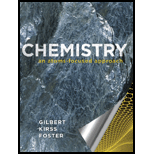
To find:
a) How much chalcopyrite had to be mined to produce one dollar’s worth of these pennies?
b) How much chalcopyrite had to be mined to produce one dollar’s worth of the pennies if the first reaction had a percent yield of
c) How much chalcopyrite had to be mined to produce one dollar’s worth of the pennies if each of the reactions proceeded with
Answer to Problem 7.90QA
Solution:
a)
b)
c)
Explanation of Solution
a) To find amount of chalcopyrite that had to be mined to produce one dollar’s worth of these pennies.
1) Formula and concept:
We are given mass of one penny, that is,
Then we know that
The reactions involved in this process of recovering
Using the mass of
2) Given:
We are given mass of one penny, that is,
3) Calculations:
The mass of Cu metal present in one penny is given by
So, the mass of Cu for 1 dollar is
To find mass of
So the amount of
b) To find the amount of chalcopyrite that had to be mined to produce one dollar’s worth of these pennies if the first reaction had percent yield of
1) Formula and concept:
The first reaction has
2) Calculations:
The amount of
Now, for the third reaction, the percent yield is 85%. So, calculating the theoretical yield as
So, the theoretical yield is
So the amount of
c) To find the amount of chalcopyrite that had to be mined to produce one dollar’s worth of the pennies if each of the reactions proceeded with 85 % yield.
We have to follow the same procedure as above, considering each reaction gives
The amount of Cu that could be produced is
i. The amount of
The amount of
The amount of
The amount of
The amount of
So,
Conclusion:
From the balanced equations, we can find out quantitative information about the reactants that need to be used or the products that could form.
Want to see more full solutions like this?
Chapter 7 Solutions
Chemistry: An Atoms-Focused Approach
 ChemistryChemistryISBN:9781305957404Author:Steven S. Zumdahl, Susan A. Zumdahl, Donald J. DeCostePublisher:Cengage Learning
ChemistryChemistryISBN:9781305957404Author:Steven S. Zumdahl, Susan A. Zumdahl, Donald J. DeCostePublisher:Cengage Learning ChemistryChemistryISBN:9781259911156Author:Raymond Chang Dr., Jason Overby ProfessorPublisher:McGraw-Hill Education
ChemistryChemistryISBN:9781259911156Author:Raymond Chang Dr., Jason Overby ProfessorPublisher:McGraw-Hill Education Principles of Instrumental AnalysisChemistryISBN:9781305577213Author:Douglas A. Skoog, F. James Holler, Stanley R. CrouchPublisher:Cengage Learning
Principles of Instrumental AnalysisChemistryISBN:9781305577213Author:Douglas A. Skoog, F. James Holler, Stanley R. CrouchPublisher:Cengage Learning Organic ChemistryChemistryISBN:9780078021558Author:Janice Gorzynski Smith Dr.Publisher:McGraw-Hill Education
Organic ChemistryChemistryISBN:9780078021558Author:Janice Gorzynski Smith Dr.Publisher:McGraw-Hill Education Chemistry: Principles and ReactionsChemistryISBN:9781305079373Author:William L. Masterton, Cecile N. HurleyPublisher:Cengage Learning
Chemistry: Principles and ReactionsChemistryISBN:9781305079373Author:William L. Masterton, Cecile N. HurleyPublisher:Cengage Learning Elementary Principles of Chemical Processes, Bind...ChemistryISBN:9781118431221Author:Richard M. Felder, Ronald W. Rousseau, Lisa G. BullardPublisher:WILEY
Elementary Principles of Chemical Processes, Bind...ChemistryISBN:9781118431221Author:Richard M. Felder, Ronald W. Rousseau, Lisa G. BullardPublisher:WILEY





